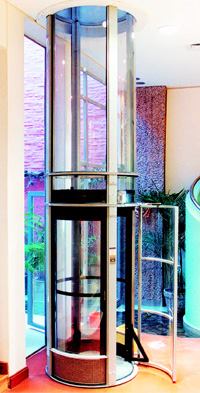The residential elevator market has spiked between 15 percent and 20 percent in the past five years, with most sales growth coming from new construction. What’s driving this surge of interest in residential elevators? Many affluent baby boomers are building their last homes, and they want to make sure that they can remain in them should they become less mobile.
But even younger custom home buyers want to show the world that they’ve arrived professionally and financially, and they see an elevator as a mark of success similar to the Mercedes in their driveway. “Twenty or 10 years ago, people would say ‘I don’t need an elevator. I can climb stairs perfectly well,’” says Jim Quinly, general manager for ThyssenKrupp Access’ residential elevator division. “But it’s not about being disabled; it’s about ease of lifestyle.” No one has to drag laundry, luggage, or recreational equipment up and down the stairs when an elevator is available to do the hard work. For some custom home owners, an elevator is a necessity that can be as low-key or as high-profile as individual taste dictates.
Recent innovations are also responsible for the increased installation of residential elevators. Traditional winding-drum and roped hydraulic systems require a separate, dedicated room to house their mechanical and drive systems. But now most manufacturers offer elevators that do not require mechanical rooms. Instead, the drive systems are mounted in the elevator shaft above or below the cab. Cutting out a machine room, typically a 4-by-4-foot space, lets the builder reclaim some livable square footage and reduce installation time.
These new elevator systems do require a few trade-offs. “If the machinery is in a separate machine room, it’s quieter in the elevator,” points out Dave Russo, vice president of elevator dealer and installer Access Elevator in Farmingdale, N.Y. “It’s a little bit of a louder ride if the machinery is in the shaft with the elevator.” Also, the elevator shaft has to be a bit taller to accommodate machinery above the cab when it reaches the top floor. Maintenance can be more difficult when the drive system and other mechanicals are inside the elevator shaft rather than in an easily accessible room, according to Rob DeRooy, vice president of sales for Concord Elevators & Lifts.
Codes have not yet caught up with the most recent developments in residential elevator technology, so the systems that do not require a mechanical room or that use a vacuum lift system may not be allowed in areas where national or state codes apply. The National Elevator Code, which has been adopted in full or in part by some states also dictates the maximum number of stops a residential elevator can have (five) and how fast it can travel (up to 40 feet per minute). Most manufacturers’ elevators run at speeds between 30 and 36 feet per minute and while some can accommodate up to five stops, others accommodate only two or three. The dealer/installer should take all measurements and communicate clearly to the builder what is required in terms of preparing the elevator shaft properly.
Pneumatic Vacuum Elevators LLC Designed to operate using air and gravity, the Pneumatic Vacuum Elevator features a clear polycarbonate tube supported by an aluminum structure, a clear polycarbonate passenger car, and a suction assembly. Vacuum pumps or turbines use air to pull the car up to the desired floor, where an anchoring system locks the car in place. The elevator does not require a pit or machine room. 305.235.6707. www.vacuumelevators.com.



